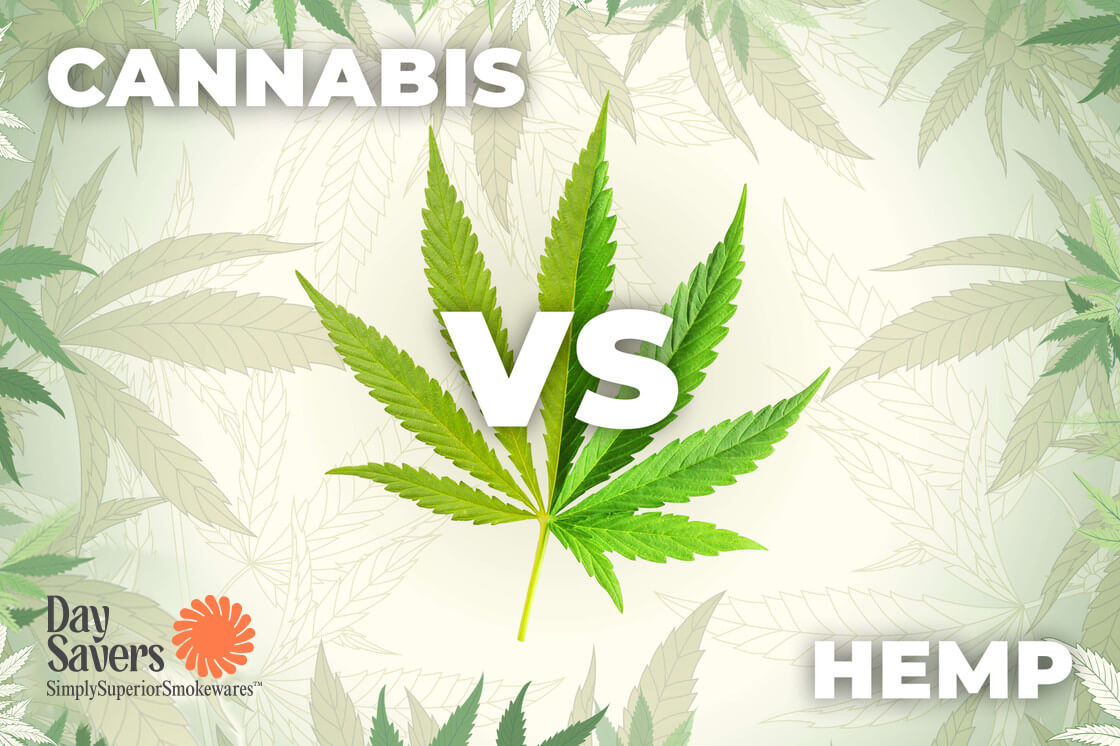Are Hemp and Marijuana the Same? 4 Important Differences Between Hemp and Cannabis
Posted by DaySavers Team on Apr 25th 2022
We get it—determining the difference between cannabis (aka marijuana, weed, pot, ganja, the Devil's Lettuce) and hemp can be confusing. Between adult-use cannabis, medicinal cannabis, CBD, hemp seed oil, and all the other cannabis- and hemp-based products on the market today, it can be hard to tell if what you just bought is something that will get you high or something that will simply be a pleasant addition to your routine.
So, are cannabis and hemp actually the same thing? Not quite. They’re different plants, but they are from the same species of fiber plant known as Cannabis Sativa.
There are a few other important differences to consider when comparing cannabis vs. hemp, including intoxicating properties, growth patterns, regulations and legality, and history. Read on to learn more.
1. Intoxicating Properties of Cannabis vs. Hemp
Tetrahydrocannabinol, or THC, is the therapeutic chemical compound that’s responsible for imparting a high. Cannabidiol, or CBD, is a similar therapeutic compound that does not impart a high. These two chemicals mark the key difference between cannabis and hemp: intoxication properties.
Cannabis is intoxicating because of its high THC content. An average cannabis plant contains 15-20% THC. This has led some states, like Montana, to put a limit on how much THC a cannabis product can have. CBD content in cannabis is usually pretty low, coming in at less than 4% for most plants.
Hemp is nonintoxicating because of its low THC content. By legal definition, hemp cannot contain more than 0.3% THC, with no exceptions . However, it usually has higher levels of CBD, ranging anywhere from 20-30%.
This difference in chemical makeup and intoxicating effects influences what each plant is used for. Cannabis, for example, has been used for years both medically and recreationally because of its medicinal and intoxicating effects. Hemp, on the other hand, is used to make therapeutic CBD products as well as industrial goods like paper, clothing, plastic, and food products such as hemp flour or hemp seed oil. Because each plant is used for different purposes, their growth patterns and conditions also differ.


2. Growth Patterns and Conditions of Cannabis vs. Hemp
Cannabis plants require stricter growing conditions than hemp because the goal is to get each plant to produce as many chemical compounds as possible, particularly THC. Hemp plants can’t have more than 0.3% THC, so their growing conditions can be laxer.
Cannabis plants need a carefully monitored environment because warmth, humidity, light, and airflow all play a factor in successful THC cultivation. Their growth cycle is typically 60-90 days.
Hemp plants are much less picky because the goal isn’t to produce high levels of THC. They can be grown in harsher climates and conditions and usually complete their growth cycle within 108 and 120 days.
The plants themselves also look different. Hemp can grow as tall as 20 feet, with skinny leaves bunched toward the top of the stem. Cannabis grows much shorter and looks more like a bush with flowers and broad leaves all over the stem.
3. Regulations and Legality of Cannabis vs. Hemp
Other than THC content, the difference in regulations and legality between hemp and cannabis could be considered the largest difference of all.
The 2018 Farm Bill officially made hemp legal to be grown and harvested by all. On the contrary, cannabis is still federally illegal, and in individual states where it is legal, it’s highly regulated. These regulations are important to note because they keep consumers aware of what’s going into their bodies.
Cannabis is heavily monitored, and its compliance laws are strictly enforced. Packaging, ingredients, pesticides, and branding are all scrutinized when it comes to growing, selling, and buying cannabis. The same cannot be said for hemp.
Hemp is simply not regulated at all. This is good because anyone can grow it, but it’s a problem because hemp brands can get away with boasting high CBD content in their products without having to prove it. This also means it’s hard to know where the hemp of your latest CBD product was sourced from or if it contains pesticides or additives. (To avoid this uncertainty, look for CBD products that include third-party lab test results.)
As an example, let’s look at hemp wraps. They’re usually made from the stalk of the plant, which contains minimal amounts of cannabinoids like THC or CBD if any at all. Yet it’s common for brands to claim high CBD content in their hemp wraps. And because there’s little regulation, they’re allowed to make these claims.
To avoid falling for marketing gimmicks, look for hemp wraps that don’t claim high levels of CBD, THC, etc., but instead boast high-quality ingredients, like our All Natural Hemp Wraps. They provide you with a smooth, even, natural burn without claiming any false information.
4. History of Cannabis and Hemp in the United States
Hemp is believed to be the first crop ever cultivated by mankind. It provided material for clothes, food, rope, housing, paper, and herbal medicine. It arrived in North America with the settlers of Jamestown, where it was an important agricultural and industrial product well before the intoxicating effects of its sister plant, cannabis, were widely known.
Cannabis, on the other hand, has a long, racially-charged history in the United States. It was legal and commonly used in the country for decades, but things started to change at the beginning of the 20th century. Racist, political, and fiscal motivations against the plant festered within the federal government, and by the 1930s, anti-cannabis propaganda was in full swing. In 1937, and in line with its newly-established stance against cannabis, the federal government passed the Marijuana Tax Act, paving the way for 80 years of cannabis prohibition, and taking hemp along with it.
As we mentioned earlier, hemp finally became federally legal again in 2018. Cannabis, however, remains federally illegal.
To (Hemp) Wrap It Up
Cannabis and hemp are plants from the same family, but they are by no means identical twins. From a chemical level, to how they’re grown, to the effects they have on our bodies, these plants are vastly different. In turn, the regulations and legality of the two are night and day, influencing how the products derived from each are packaged, distributed, and sold.
When deciding which plant is a better fit for you, the main questions to ask yourself are: What’s my end goal? (Do you want to be high or not?) And, what’s my preferred consumption method?
If you’re not sure about the best consumption method for you, check out our recent blog that debunks the most common myths about smoking cannabis.



